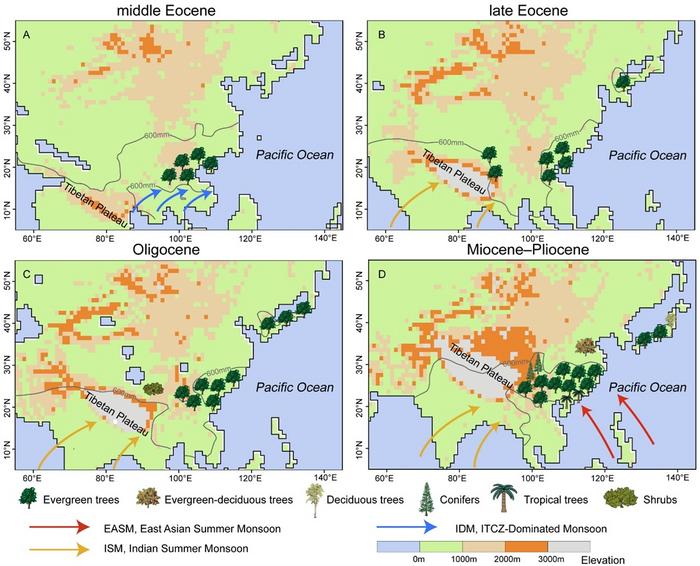Evergreen broad-leaved forests (EBLFs) are the most characteristic biomes in East Asia. They assume a fundamental role in the biodiversity function and ecosystem services of the East Asiatic floristic kingdom. Hence, understanding the historical dynamics of EBLFs and their underlying drivers is crucial for conserving their diversity in the region.

Credit: Jiagang Zhao and Shufeng Li
Evergreen broad-leaved forests (EBLFs) are the most characteristic biomes in East Asia. They assume a fundamental role in the biodiversity function and ecosystem services of the East Asiatic floristic kingdom. Hence, understanding the historical dynamics of EBLFs and their underlying drivers is crucial for conserving their diversity in the region.
Nevertheless, the occurrence of EBLFs remains controversial across various disciplines. Several recent paleobotanical studies have indicated that EBLFs were likely established during the Middle Eocene in southestern China China and late Eocene–early Oligocene in southwestern China, potentially earlier than the molecular dating studies. Moreover, plant fossil records provide more direct and reliable evidence, with high-quality geochronology and unique taphonomy enabling a spatial-temporal exploration into the occurrence of EBLFs.
In a study published in the KeAi journal Plant Diversity, a team of researchers from the Xishuangbanna Tropical Botanical Garden (XTBG), Chinese Academy of Sciences (CAS), tapped plant fossils to explore where and where EBLFs occurred in East Asia.
“Modern EBLFs are primarily characterized by families including Fagaceae, Lauraceae, Magnoliaceae and Theaceae,” explains Zhekun Zhou, senior and co-corresponding author the study. This biome typically occurred under monsoon climate, with hot, moist summers and fairly cold winters. Therefor paleoclimate and paleovegetation of fossil assemblages primarily serve as important indicators to identify the occurrence of EBLFs.”
Compiling a dataset of Cenozoic palaeobotanical records from four regions (southwestern China, southern China, central-eastern China and Japan) in East Asia, the researchers reconstructed the fossil history for EBLFs’ dominant genera, calculated the paleoclimate and determined the most similar extant vegetation for each fossil assemblage.
“The results showed that most plant fossil assemblages have taken the appearance of EBLFs in East Asia during geological time. Combining the peak period of appearance for dominant genera and location of fossil sites, this inferred that occurrence of EBLFs has a different temporal-spatial pattern,” adds Zhou.
Further, the research collaborated with Prof. Paul J. Valdes and Dr. Alex Farnsworth to conduct paleoclimate simulations based on the Hadley Centre Coupled Model version3 (HadCM3) at the University of Bristol in the UK.
Through a comparison of the quantitative reconstruction and simulated outputs, they deduced that the precipitation of wettest quarter (PWetQ) exceeding 600 mm is an important factor for the occurrence of EBLFs. Combined with the latest studies on the Asian monsoon, this study suggested that the multistage evolution of Asian monsoon led to a diverse occurrence of EBLFs in East Asia.
“In contrast to the previously prevailing views, our findings highlight that the EBLFs in East Asia occurred in different temporal-spatial patterns,” Zhou concludes.
###
Contact the author: Yaowu Xing, Zhekun Zhou. Xishuangbanna Tropical Botanical Garden, Chinese Academy of Sciences,ywxing@xtbg.org.cn; zhouzk@xtbg.ac.cn
The publisher KeAi was established by Elsevier and China Science Publishing & Media Ltd to unfold quality research globally. In 2013, our focus shifted to open access publishing. We now proudly publish more than 100 world-class, open access, English language journals, spanning all scientific disciplines. Many of these are titles we publish in partnership with prestigious societies and academic institutions, such as the National Natural Science Foundation of China (NSFC).
Journal
Plant Diversity
Method of Research
Data/statistical analysis
Subject of Research
Not applicable
Article Title
Heterogeneous occurrence of evergreen broad-leaved forests in East Asia: Evidence from plant fossils
COI Statement
The authors declare that they have no known competing financial interests or personal relationships that could have appeared to influence the work reported in this paper.



